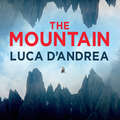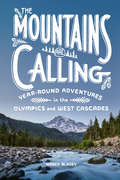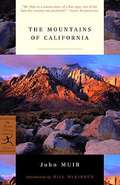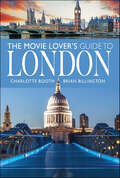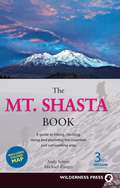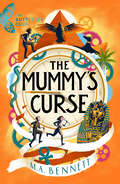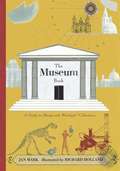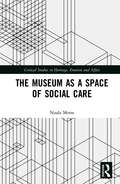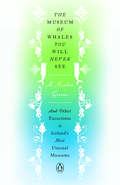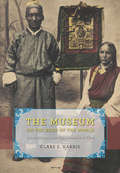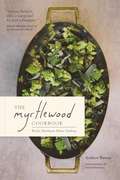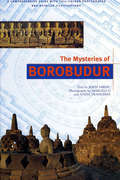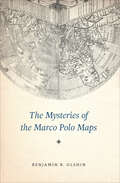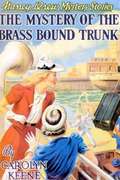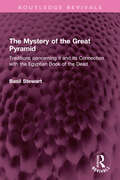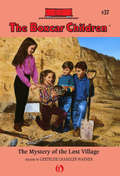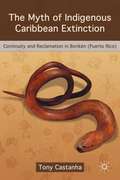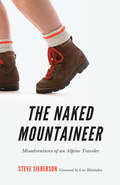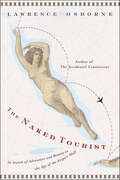- Table View
- List View
The Mountain: The Breathtaking Italian Bestseller
by Luca D'AndreaAn atmospheric commercial thriller channeling Stephen King and Joël DickerJeremiah Salinger blames himself. The crash was his fault. He was the only survivor. Now only his daughter Clara can put a smile on his face. The depression and the nightmares are closing in. But when he takes Clara to the Bletterbach - a canyon in the Dolomites rich in fossil remains - he overhears by chance a conversation that gives his life renewed focus. In 1985 three students were murdered there, their bodies savaged, limbs severed and strewn by a killer who was never found. Salinger, a New Yorker, is far from home, and these Italian mountains, where his wife was born, harbour a close-knit, tight-lipped community whose mistrust of outsiders can turn ugly. All the same, solving this mystery might be the only thing that can keep him sane.(P)2017 WF Howes Ltd.
The Mountains Are Calling: Year-Round Adventures in the Olympics and West Cascades
by Nancy BlakeyLooking for easily accessible yet off-the-beaten-path outdoor adventures you can do year-round in the mountains near Seattle, Portland, and Bend? Look no further!Imagine escaping to old-growth forests, snow-capped peaks, waterfalls, and hot springs. This beginner-friendly guide will show you where to go, what to do, and what to look for while you&’re there. Covering the Olympics and West Cascades (Olympic Peninsula, Mount Baker, Central Cascades, Mount Rainier, Mount St. Helens, Mount Hood, Deschutes National Forest, and Crater Lake) the book features a robust basics section with tips, gear guides, nature ID, geology, and safety info. Each mountain location includes background information, getaways (to campgrounds, cabins, lodges, fire lookouts, and yurts), and activities (green season and snow season). Green season features spring/summer/fall hikes and backpacking trips, while snow season includes downhill skiing, snowboarding, cross country skiing, snowshoeing, winter hikes, and more. Activities are coded with icons (accessible, near campground, wildflower, berry picking, bird watching, dogs allowed, wow-factor, waterfall) and are indexed by icon at the end. This book will inspire you to get outdoors all year long with beautiful photography and illustrations, evocative descriptions, maps, and all the basics you need to know to go.
The Mountains of California
by John MuirA reprint of the Century Co. edition of 1894 with illustrations added from Picturesque California and the region west of the Rockies.
The Movie Girl
by Kate LacePinning tight clothing to unnervingly handsome actors – now there’s a job fashionista Gemma would be crazy to pass up. That’s why she’s delighted to find herself working as assistant wardrobe mistress on a huge, lavishly produced film. And the movie’s sexy star, A-lister Jono Knighton, has taken a real shine to her, so life just gets better and better. There’s just the small matter of Jono’s wife, the petrifying Rowan, to consider...
The Movie Lover's Tour of Texas: Reel-Life Rambles Through the Lone Star State
by Veva VonlerTexas movies are as vast as the Lone Star State. This book offers readers the chance to visit Texas vicariously by viewing movies filmed in and about the state that reflect Texas history, cultures, and landscapes. Suggested itineraries, maps, and lists of unique shooting locatiosn make this book a travel guide. Anecdotes about the experiences of the movie makers during the filming add unique interest for the movie fan.
The Movie Lover’s Guide to London (City Guides)
by Charlotte Booth Brian BillingtonLondon is a magical place which has intrigued people for more than 2,000 years, and never is this more apparent than in the past 130 years following the invention of the moving image. London has been a draw for filmmakers for decades, and this book guides you through the locations, in the shadow of some of your favorite movies. Take a tour by movie, go on a movie pub crawl, a leisurely stroll through cemeteries with connections to the movies or create your own tour by postcode. This book will allow you to visit new parts of London but with the familiarity of a well-loved film. With more than 500 movie locations from 91 films covering more than six decades of movie making and more than 100 images, this book will have something for everyone and will show you London in a new, sparkling, glamourous light.
The Mt. Shasta Book
by Andy Selters Michael ZangerThe Mt. Shasta Book is the ultimate guide to safely the hiking, backpacking, and climbing routes up the 14,162-foot mountain. In addition, this guide covers the area's skiing, snowboarding, water activities, and mountain biking trails. With over 50 combined years of experience as Shasta guides, the authors are seasoned experts on the mountain and its surroundings. The print edition comes with a fold-out 4-color topographic map.
The Mummy's Curse: Book 2 - A time-travelling adventure to discover the secrets of Tutankhamun (The Butterfly Club #2)
by M.A. BennettWould you risk the future to change the past?Greenwich, London, 1894.Luna, Konstantin and Aidan are time-travelling thieves, stealing artefacts from the future to bring progress forward. And they are about to venture on their most treacherous mission.For The Butterfly Club have their eyes on a shiny new prize. In Egypt's Valley of the Kings a man named Howard Carter will stumble upon an unimaginable treasure – Tutankhamun's mummy: the greatest archaeological discovery of all time.The three children are given an impossible task: travel to 1922 and uncover the mummy first. But when the time-thieves disturb Tutankhamun's long sleep they wake something else too – a deadly and ancient curse. And now they must face the terrifying consequences of their actions...
The Museum Book: A Guide to Strange and Wonderful Collections
by Jan MarkJan Mark takes readers through museums' multifaceted history. Numerous questions answer in the books are: What is a museum? Why would anyone amass shells, words, clocks, teeth, trains, dinosaurs, mummies...or two-headed sheep? Find out where the word "museum" comes from and what unusual items (unicorn horns? mermaids?) some early museums placed on view. <P><P> [This text is listed as an example that meets Common Core Standards in English language arts in grades 2-3 at http://www.corestandards.org.]
The Museum Book: A Guide to Strange and Wonderful Collections (Into Reading, Trade Book #10)
by Jan Mark Richard HollandNIMAC-sourced textbook
The Museum as a Space of Social Care (Critical Studies in Heritage, Emotion and Affect)
by Nuala MorseThis book examines the practice of community engagement in museums through the notion of care. It focuses on building an understanding of the logic of care that underpins this practice, with a view to outlining new roles for museums within community health and social care. This book engages with the recent growing focus on community participation in museum activities, notably in the area of health and wellbeing. It explores this theme through an analysis of the practices of community engagement workers at Tyne & Wear Archives & Museums in the UK. It examines how this work is operationalised and valued in the museum, and the institutional barriers to this practice. It presents the practices of care that shape community-led exhibitions, and community engagement projects involving health and social care partners and their clients. Drawing on the ethics of care and geographies of care literatures, this text provides readers with novel perspectives for transforming the museum into a space of social care. This book will appeal to museum studies scholars and professionals, geographers, organisational studies scholars, as well as students interested in the social role of museums.
The Museum of Whales You Will Never See: And Other Excursions to Iceland's Most Unusual Museums
by A. Kendra GreeneMythic creatures, natural wonders, and the mysterious human impulse to collect are on beguiling display in this poetic tribute to the museums of an otherworldly island nation.Iceland is home to only 330,000 people (roughly the population of Lexington, Kentucky) but more than 265 museums and public collections--nearly one for every ten people. They range from the intensely physical, like the Icelandic Phallological Museum, which collects the penises of every mammal known to exist in Iceland, to the vaporously metaphysical, like the Museum of Icelandic Sorcery and Witchcraft, which poses a particularly Icelandic problem: How to display what can't be seen? In The Museum of Whales You Will Never See, A. Kendra Greene is our wise and whimsical guide through this cabinet of curiosities, showing us, in dreamlike anecdotes and more than thirty charming illustrations, how a seemingly random assortment of objects--a stuffed whooper swan, a rubber boot, a shard of obsidian, a chastity belt for rams--can map a people's past and future, their fears and obsessions. "The world is chockablock with untold wonders," she writes, "there for the taking, ready to be uncovered at any moment, if only we keep our eyes open."
The Museum on the Roof of the World: Art, Politics, and the Representation of Tibet
by Clare E. HarrisFor millions of people around the world, Tibet is a domain of undisturbed tradition, the Dalai Lama a spiritual guide. By contrast, the Tibet Museum opened in Lhasa by the Chinese in 1999 was designed to reclassify Tibetan objects as cultural relics and the Dalai Lama as obsolete. Suggesting that both these views are suspect, Clare E. Harris argues in The Museum on the Roof of the World that for the past one hundred and fifty years, British and Chinese collectors and curators have tried to convert Tibet itself into a museum, an image some Tibetans have begun to contest. This book is a powerful account of the museums created by, for, or on behalf of Tibetans and the nationalist agendas that have played out in them. Harris begins with the British public’s first encounter with Tibetan culture in 1854. She then examines the role of imperial collectors and photographers in representations of the region and visits competing museums of Tibet in India and Lhasa. Drawing on fieldwork in Tibetan communities, she also documents the activities of contemporary Tibetan artists as they try to displace the utopian visions of their country prevalent in the West, as well as the negative assessments of their heritage common in China. Illustrated with many previously unpublished images, this book addresses the pressing question of who has the right to represent Tibet in museums and beyond.
The Myrtlewood Cookbook: Pacific Northwest Home Cooking
by Peter Schweitzer Andrew BartonExperience beautiful home cooking that takes its cues from the kitchen gardens and forest harvests of the Pacific Northwest. Andrew Barton and his friends run Secret Restaurant Portland, a monthly supper club. After hosting dinners for five years, a culinary style emerged that reflected his practical approach to cooking: accessible recipes alive with flavor, lovely on the plate and the palate. The Myrtlewood Cookbook brings forth 100 recipes that amplify the tastes, colors, and textures of summer tomatoes, fall mushrooms, winter roots, and spring greens. You will gain nearly as much from reading these recipes as from cooking them. Whether you are inspired to make Nettle Dumplings in Sorrel Broth, Candied Tomato Puttanesca, or Russet/Rye Apple Pie, be prepared to swoon under the spell of Myrtlewood.* *The Myrtlewood tree is found on the same ground as fiddlehead ferns, nettles, and other wild foods characteristic of the Pacific Northwest. The plates, bowls and cutting boards carved from Myrtlewood shown in this book connect to the land where this cookbook was created.
The Mysteries of Borobudur
by Marcello And Tranchini John MiksicThe Mysteries of Borobudur provides a comprehensive guide to the history and architecture of the monument in word and picture, with an informative text, complemented by colour photographs, maps, site plans and other visual materials
The Mysteries of Borobudur
by John Miksic Marcello TranchiniThe Mysteries of Borobudur provides a comprehensive guide to the history and architecture of the monument in word and picture, with an informative text, complemented by colour photographs, maps, site plans and other visual materials
The Mysteries of the Marco Polo Maps
by Benjamin B. OlshinWhat&’s the truth behind the travels of Marco Polo? &“A fascinating tale about maps, history and exploration.&”—Times Literary Supplement (UK) In the thirteenth century, Italian merchant and explorer Marco Polo traveled from Venice to the far reaches of Asia, a journey he chronicled in a narrative titled Il Milione, later known as The Travels of Marco Polo. While Polo&’s writings would go on to inspire the likes of Christopher Columbus, scholars have long debated their veracity. Some have argued that Polo never even reached China—while others believe that he came as far as the Americas. Now, there&’s new evidence for this historical puzzle: a very curious collection of fourteen little-known maps and related documents said to have belonged to the family of Marco Polo himself. Here, historian of cartography Benjamin B. Olshin offers the first credible book-length analysis of these artifacts, charting their course from obscure origins in the private collection of Italian-American immigrant Marcian Rossi in the 1930s; to investigations of their authenticity by the Library of Congress, J. Edgar Hoover, and the FBI; to the work of the late cartographic scholar Leo Bagrow; to Olshin&’s own efforts to track down and study the Rossi maps, all but one of which are in the possession of Rossi&’s great-grandson. Are the maps forgeries, facsimiles, or modernized copies? Did Marco Polo&’s daughters—whose names appear on several of the artifacts—preserve in them geographic information about Asia first recorded by their father? Or did they inherit maps created by him? Did Marco Polo entrust the maps to an admiral with links to Rossi&’s family line? Or, if the maps have no connection to Marco Polo, who made them, when, and why? Regardless of the maps&’ provenance, this tale takes us on a fascinating journey, offering insights into Italian history, the age of exploration, and the wonders of cartography. &“Olshin&’s book tugs powerfully at the imagination of anybody interested in the Polo story, medieval history, old maps, geographical ideas, European voyages of discovery, and early Chinese legends.&”—The Wall Street Journal
The Mystery Of The Brass Bound Trunk (Nancy Drew Mystery Stories #17)
by Carolyn Keene Russell H. TandyA trunk that Nancy receives from her father for a trip to Buenos Aires becomes the center of a mystery. Beginning in the late 1950s, the Nancy Drew books were revised and condensed. This is the version published in 1934, before the changes.
The Mystery of the Great Pyramid: Traditions concerning it and its Connection with the Egyptian Book of the Dead (Routledge Revivals)
by Basil StewartFirst published in 1929, The Mystery of the Great Pyramid attempts to unravel the secrets of the Great Pyramid by drawing parallels with the rituals in the Book of the Dead. The conception of the Pyramid and the origin of the cult of Osiris and of the Book of the Dead are to be found in a common source, which maybe expressed in the one word, Messianism. The author argues that this is why the literature of early Christian gnosticism abounds in mystical pyramid figures and associated astronomical conceptions and constellations. This book will be of interest to students of history, philosophy, and theology.
The Mystery of the Lost Village (Boxcar Children #37)
by Gertrude Chandler Warner Charles TangWhen the Aldens try to save a forest from developers in a Navaho Indian reservation by proving there is a lost village there, they're met with sabotage.
The Mystery of the Vasa (Fountas & Pinnell LLI Purple #Level S)
by Barbara FiermanFor hundreds of years the sinking of the Swedish warship Vasa was an unsolved mystery. But when a Swedish amateur archaeologist named Anders Franzen let his curiosity get the best of him, he was motivated to solve the mystery. This book describes the salvage and preservation of the Swedish warship Vasa that sank in Stockholm harbor on her maiden voyage in 1628.
The Mystical Backpacker
by Hannah PappPart memoir, part guidebook, The Mystical Backpacker invites you to explore your inner terrain and learn how to create your own unique version of a modern day vision quest or walk-about. Tired of living a life based on other's expectations, Hannah Papp quit her job, bought a EuroRail ticket and a map, notified her landlady, and left town. Embarking on a journey across Europe with no plan and no direction, Hannah stumbled into becoming a modern-day Mystical Backpacker. Along the way her discoveries and the teachers she encountered allowed her to go on a deeper journey into the self and the spirit--revealing the real self she had long been missing. The Mystical Backpacker shows you how to identify the signs along the road that will lead to teachers and experiences that will reorient your own life map. Ultimately, The Mystical Backpacker offers a solution, a way to break free and find your inner self's rhythms and needs, fulfilling your true destiny. It's time you hit the road and become a mystical backpacker.
The Myth of Indigenous Caribbean Extinction
by Tony CastanhaThis book debunks one of the greatest myths ever told in Caribbean history: that the indigenous peoples who encountered a very lost Christopher Columbus are 'extinct. ' Through the uncovering of recent ethnographical data, the author reveals extensive narratives of Jíbaro Indian resistance and cultural continuity on the island of Borikén.
The Naked Mountaineer: Misadventures of an Alpine Traveler
by Stephen C. Sieberson Lou WhittakerThe Naked Mountaineer recounts a series of solo journeys to some of the world’s most exotic peaks in places such as Switzerland, Japan, and Borneo. However, it is far from the typical heroic mountain-expedition book. Although Steve Sieberson did reach many summits, in most cases his travels were more memorable for what he encountered along the way than for the actual climbing. His real adventures involved peculiar people, strange foods, and tropical diseases, rather than pitons, ice axes, and carabiners. On the Matterhorn he met an English alpinist who reveled in naked selfies, he stumbled into a cockfight in a Balinese village, and on a volcano in Italy he was mistaken for a famous singer by an insistent fan.The Naked Mountaineer offers mountain-themed travel stories with a wide-eyed view of the world, while presenting irreverent commentary on climbers and their peculiar sport. These are rollicking tales, filled with the unexpected.
The Naked Tourist: In Search of Adventure and Beauty in the Age of the Airport Mall
by Lawrence OsborneFrom the theme resorts of Dubai to the jungles of Papua New Guinea, a disturbing but hilarious tour of the exotic east—and of the tour itselfSick of producing the bromides of the professional travel writer, Lawrence Osborne decided to explore the psychological underpinnings of tourism itself. He took a six-month journey across the so-called Asian Highway—a swathe of Southeast Asia that, since the Victorian era, has seduced generations of tourists with its manufactured dreams of the exotic Orient. And like many a lost soul on this same route, he ended up in the harrowing forests of Papua, searching for a people who have never seen a tourist. What, Osborne asks, are millions of affluent itinerants looking for in these endless resorts, hotels, cosmetic-surgery packages, spas, spiritual retreats, sex clubs, and "back to nature" trips? What does tourism, the world's single largest business, have to sell? A travelogue into that heart of darkness known as the Westernmind, The Naked Tourist is the most mordant and ambitious work to date from the author of The Accidental Connoisseur, praised by The New York Times Book Review as "smart, generous, perceptive, funny, sensible."
